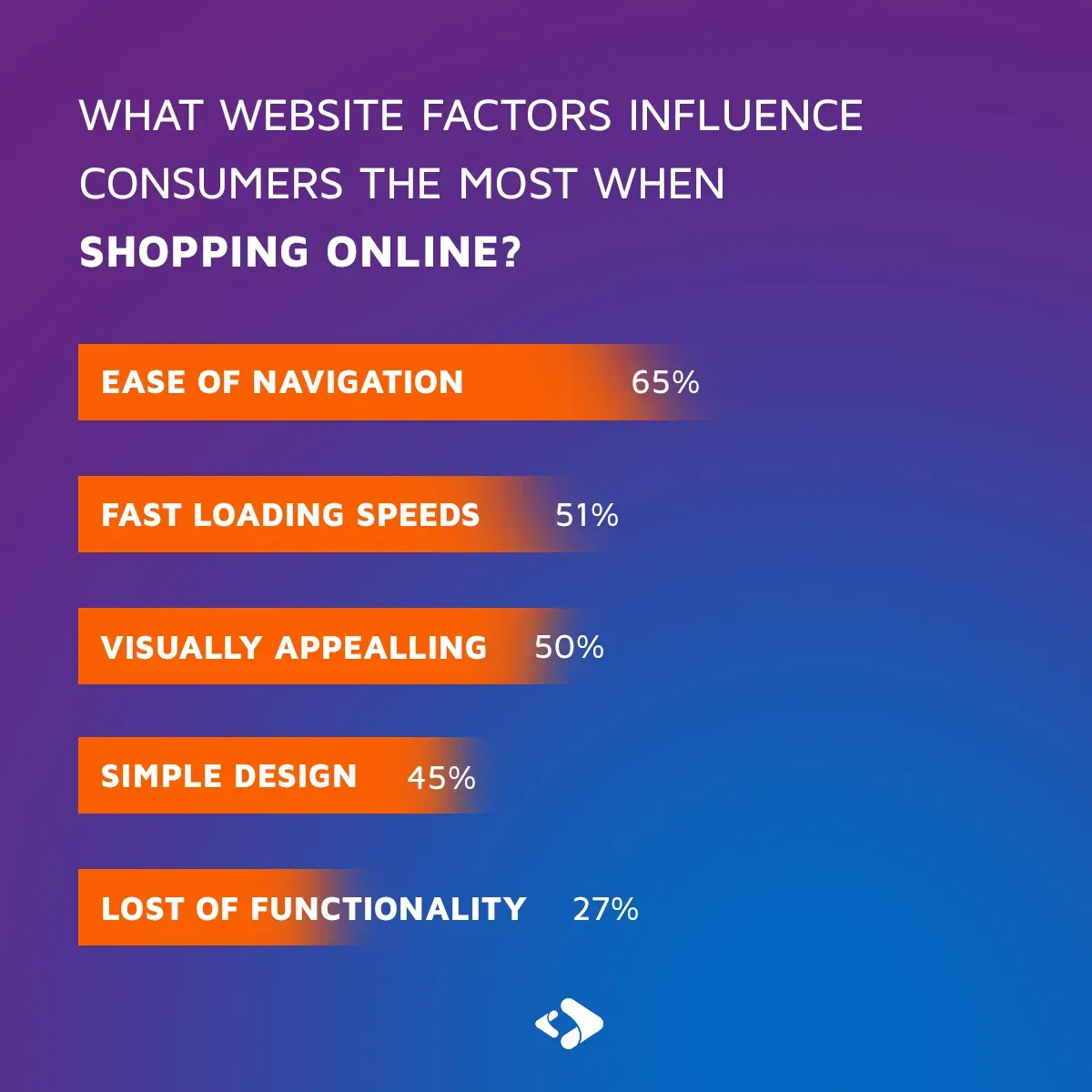The 3-Second Threshold of Page Load Speed

The Importance of Page Speed Optimization for eCommerce Websites
In today's digital landscape, we cannot overstate the importance of website speed. With ever-shortening attention spans and an abundance of options at their fingertips, users have little patience for slow-loading pages.
For eCommerce businesses, site speed is especially critical, as it directly impacts key metrics like conversion rates, bounce rates, and revenue. This guide will discuss the importance of page speed. It will explain important metrics and analyze how speed affects user experience and SEO. Additionally, it will provide tips for improving the speed of an eCommerce website.
Why Does Page Speed Matter?
Quite simply, faster websites make more money. Research by the Aberdeen Group found that a 1-second delay in page load time can result in:
7% loss in conversions- 16% decrease in customer satisfaction
- 11% fewer page views
According to
Google, as page load time increases from 1 second to 3 seconds, the probability of bounce increases to 32%. When page load time increases from 1 second to 5 seconds, the probability of bounce increases to an outstanding 90%. For eCommerce sites, this means direct revenue losses from abandoned shopping carts and missed sales opportunities.
Beyond conversion metrics, site speed impacts user experience and engagement. Users expect a seamless, satisfying experience—slow load times break immersion and cause frustration. In a study by
Google, 53% of mobile users abandoned sites that took over 3 seconds to load. Optimizing speed is crucial for keeping visitors engaged.
From an SEO standpoint, site speed is a ranking factor. Google has explicitly stated that page speed impacts search rankings, as part of delivering a good user experience. Faster sites tend to rank higher in SERPs.
It's clear that page speed optimization should be a top priority for eCommerce businesses. The following sections explore the impact of speed on UX, SEO, and conversions in more depth.
What Are Key Page Speed Metrics?
To measure and monitor the speed of an eCommerce site, there are a few key metrics to pay attention to:
Page load time:
Measures how long it takes for the full page to load, including all page elements. This is the most straightforward metric of site speed. As a best practice, always aim for a page load time of under 2 seconds.
First meaningful paint:
Measures when the primary page content first renders on the screen. This marks the first “meaningful” paint when users can begin to digest the content. Target under 1 second.
Time to interactive:
Measures how long until a page is fully interactive and responsive to input. For eCommerce sites, this is critical—users need to be able to quickly tap buttons, scroll, and input information. The ideal time is under 5 seconds.
First CPU idle:
Measures when a page is minimally demanding on the device CPU after loading. Lower CPU demand enables smooth scrolling, animation, and tracking user events. Target under 2 seconds to first CPU idle.
Largest contentful paint:
Notes when the largest content element finished rendering. For eCommerce, this is often a prominent product image or CTA button. Keep under 2.5 seconds.
When optimizing for speed, monitor these metrics regularly to quantify improvements. Integreat Commerce provides advanced website speed analytics to track these KPIs and identify optimization opportunities.
The Impact of Page Speed on User Experience
Website speed plays a pivotal role in delivering an exceptional user experience. Site performance intricately ties eCommerce user experience from first impression to ability to complete transactions.
First Impressions Matter:
Users form an almost instantaneous first impression of a website based on its visual appeal and responsiveness. Pages that load slowly betray a lack of attention to performance. This sets negative expectations even before users begin to digest content.
Conversely, fast loading pages signal high-quality engineering behind the site. Users perceive such sites as more credible and enjoyable to use. Speed optimizations can dramatically improve first impressions.
Reducing Bounce Rates:
High bounce rates negatively impact eCommerce revenue. When users leave your site immediately after landing on a page, you lose out on conversions.
Slow loading times on a webpage lead to higher bounce rates from frustrated users exiting the site. By optimizing speed, eCommerce sites can reduce bounce rates.
Higher Engagement and Loyalty:
Well-executed web experiences lead to higher engagement with page content. Fast loading makes it easy to navigate through the website, and browse more products.
When load times are short, users can easily view product pages, watch videos, and interact with site content without any annoyance.
This leads to greater customer loyalty over the long-term. Shoppers gravitate towards eCommerce sites that offer satisfying and easy to navigate user experiences. Page speed optimizations help build engagement and loyalty.
Quicker Key eCommerce Actions:
Key online shopping actions include reading product descriptions, adding items to your cart, and starting the checkout process. Slow load times severely hinder the ability to complete these actions.
Buttons, calls-to-action, and forms must load quickly for users to add items and make purchases seamlessly. Optimizing page speed enables faster completion of key actions, leading to higher conversion rates.
Improving page speed enhances user experience and boosts eCommerce performance. It achieves this by creating a positive first impression and keeping users engaged.

How Page Speed Affects Conversion Rates
Beyond UX, page speed also impacts search engine optimization (SEO) and rankings. As part of delivering a good user experience, Google now incorporates site speed as a ranking factor. Faster sites can gain an SEO advantage.
Direct Impact on Google Rankings: In 2010, Google first began incorporating site speed in its ranking algorithm. Since then, Google has placed greater and greater importance on page speed as a ranking factor.
While not the only factor, page load time does directly influence search rankings. All else being equal, faster sites tend to outrank slower sites. Speed optimizations can provide an SEO boost.
Metrics Such as Time to Interactive and LCP: Specifically, Google looks heavily at page speed metrics like Time to Interactive and Largest Contentful Paint. These measure how quickly pages become responsive and render main content.
Sites that score well on these metrics tend to see search ranking advantages. Google wants to surface fast, engaging pages to searchers. Optimizing for interactivity and main content load times can improve SEO.
Indirect Ranking Factors Like Bounce Rate: Additionally, page speed has indirect SEO benefits. As mentioned earlier, faster pages see lower bounce rates. Bounce rate is an indicator of user experience, and factors into rankings.
By reducing bounce rates through speed optimizations, sites can further enhance their SEO performance. The indirect benefits compound upon the direct ones.
Mobile Optimization Is Critical: Google also places heavy emphasis on mobile site speed when determining rankings. With over 50% of search traffic now coming from mobile, optimizing mobile page speed is mandatory for SEO.
Fast page loads for mobile users keep online shoppers engaged while browsing on mobile devices. In contrast, slow mobile speeds lead to abandonment, which harms rankings. Tackling mobile page speed is hugely impactful for on-page SEO.
In summary, page load times are indispensable for succeeding with modern SEO. Speed impacts both direct algorithmic ranking factors and indirect signals like bounce rate. eCommerce sites must address speed to maximize search visibility.
How to Speed Up Web Page Loading Time
After understanding the various reasons why page speed is crucial, let's end with practical advice on improving an eCommerce website's speed.
Enable compression:
Compress images, CSS/JS files, and other assets. Compression minimizes file sizes for faster loads.
Optimize images:
Resize images for appropriate size, enable lazy loading, and use next-gen formats like WebP. These techniques significantly speed up image load times.
Minify code:
Minify HTML, CSS, and JavaScript code by removing unnecessary spaces, comments, and characters without altering functionality. This streamlines code for faster processing.
Limit redirects:
Reduce unnecessary redirects that create extra round-trip requests. Examine 301s and chains of server-side redirects.
Reduce server response time:
Upgrade hosting plans if needed and optimize databases. Faster page load times directly link to faster server response times.
Fix broken links:
Identify and fix broken links, images, and other assets that block rendering. These errors slow down page load.
Defer offscreen content:
Defer loading of offscreen content like images in long feeds. Prioritize content users see first.
Optimize web fonts:
Limit custom web fonts and icon fonts which require extra requests. Fall back to system fonts when possible.
Replace outdated platforms and plugins:
Switching to modern, actively updated eCommerce platforms and plugins can significantly speed up sites.
Analyze real user data:
Leverage real user monitoring and web vitals analysis to identify true bottlenecks in user journeys. This will indicate the issues that prevent potential customers from completing purchases, or shopping for more items.
Final Thoughts on How To Improve Page Load Speed
Page speed optimization is mission-critical for the success of eCommerce websites in today's ultra-competitive online shopping landscape. As we have explored extensively, a site's loading times have a profound impact across all key business metrics:
- Fast speeds create good first impressions and keep users focused on site content without distractions or frustrations from slow pages. This cultivates greater engagement and loyalty over time.
- Faster websites rank higher in search engines due to factors like page speed and lower bounce rates. Higher SERP rankings increase organic traffic.
- Fast-loading pages increase conversion rates, revenue, average order values, and reduce cart abandonment. They also prevent visitors from leaving and boost overall sales.
Studies have conclusively shown slow page speeds equal lost revenue. According to one Shopify, 70% of shoppers say slow-loading eCommerce sites decrease their willingness to make a purchase. A Storyblok survey found that 60% of consumers will abandon 5 or more purchases per year due to delays from site speed and UX problems, costing an estimated $72,000 in lost sales per year.
In today’s ultra-competitive landscape, fast page loads are mandatory to provide a frictionless buying experience. Even small delays lead to higher bounce rates and missed sales.
Yet, many merchants still underestimate and under-prioritize page speed. Legacy systems, bloated code, oversized images, and poorly optimized web hosting can drag down site performance. Not monitoring and improving page load times leads to bad user experiences, less organic traffic, and leaks in the conversion funnel.
At Integreat Commerce, our technical experts focus exclusively on eCommerce optimization. We employ proven page speed optimization service to systematically identify and eliminate bottlenecks. Compression, image upgrades, minimized code, optimized databases, and cutting-edge hosting solutions are just a few of the strategies we leverage. Our optimized sites load 2-3X faster on average, boosting key metrics like conversion rate, order value, and annual sales.
We would be delighted to put our eCommerce page speed optimization service to work for you. Contact us today to request a complimentary website performance audit and action plan. Faster speeds await!



